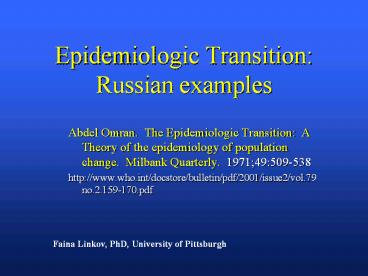Epidemiologic Transition: Russian examples PowerPoint PPT Presentation
Title: Epidemiologic Transition: Russian examples
1
Epidemiologic TransitionRussian examples
- Abdel Omran. The Epidemiologic Transition A
Theory of the epidemiology of population change.
Milbank Quarterly. 197149509-538 - http//www.who.int/docstore/bulletin/pdf/2001/issu
e2/vol.79no.2.159-170.pdf
Faina Linkov, PhD, University of Pittsburgh
2
Questions to be discussed at the end of the
lecture
- Can Omrans theory be applied to changing
mortality patterns in Russia? - Epidemiologic transition in Russia did it take
place? - Reversal of transition in Russia. How does it
relate to Omrans theory?
3
(No Transcript)
4
Epidemiologic transition Definition
- The epidemiologic transition is that process by
which the pattern of mortality and disease is
transformed from one of high mortality among
infants and children and episodic famine and
epidemic affecting all age groups to one of
degenerative and man-made diseases (such as those
attributed to smoking) affecting principally the
elderly. - Encyclopedia Britanica
5
Stages of Epidemiological Transition
- Age of Pestilence and Famine
- Age of Receding Pandemics
- Age of Degenerative and Man-made diseases
6
Age of Pestilence and Famine
- Characterized by high mortality rates, wide
swings in the mortality rate, little population
growth and very low life expectancy
- Traditional society, chronic shortage of food,
poor sanitary conditions, high MCH morbidity and
mortality, environmental problems, young
population
7
Peter I, the first emperor of Russia
8
Age of Receding Pandemics
- Epidemics become less frequent, infectious
diseases in general become less frequent, a slow
rise in degenerative diseases begin to appear,
improved life expectancy, organized health
services, increased proportion of older people
9
Alexander III, the last Russian Emperor to die
from natural causes
10
Age of Degenerative and Man-made diseases
- Chronic diseases, cheap calories, morbidity
overshadows mortality, rise in living standards,
dramatic decline in fertility, comprehensive
healthcare
11
Mickhail Gorbachev, the first and the last
President of the USSR
12
Infant Mortality Rate in Russia 1940-1993
13
Theory criticisms
14
Applications of Omrans Theory to Russia
Difficulties in Applying the General Rules
- Increased morbidity associated with WWI and WWII,
famines, and political repressions - Reverse transition in 1990s
- Excess mortality for Russian males
15
Russias transition in 1990s
16
Net Migration and Natural Increase in Russia,
19802001
17
Russia decreasing population
18
The health care principles upon which the Soviet
health care system was to be based (Nikolai
Semashko)
- government responsibility for health
- universal access to free services
- a preventive approach to social diseases
- quality professional care
- a close relation between science and medical
practice - continuity of care between health promotion,
treatment and rehabilitation.
19
Next steps following the establishment of the
Semashko model in 1918
- The health care system was under the centralized
control of the state, which financed services by
general government revenues as part of national
social and economic development plans. - All health care personnel became employees of the
centralized state, which paid salaries and
provided supplies to all medical institutions. - The main policy orientation throughout this
period was to increase numbers of hospital beds
and medical personnel.
20
Next steps following the establishment of the
Semashko model in 1918 (cont.)
- Russia made massive strides in arresting the
spread of infectious diseases. - Drastic epidemic control measures were
implemented, particularly in the cases of
tuberculosis, typhoid fever, typhus, malaria and
cholera. - These involved community prevention approaches,
routine check-ups, improvements in urban
sanitation and hygiene, quarantines, etc.
21
The period until 1991Life expectancy (both
sexes)
22
The period until 1991Life expectancy in 1965
23
A campaign against alcohol
- By the 1980s, the gap between Russia and Western
countries in life expectancy at birth came to
about 10 years for men and 6 years for women,
mostly due to high death rates among those of
working age (6). In the mid-1980s, the government
made an attempt to address this problem (9). It
was by then generally understood that potentially
avoidable human losses were mostly attributable
to excess adult age mortality from particular
causes such as injuries, accidental poisoning,
suicide, homicide, sudden cardiac death,
hypertension and other conditions closely related
to alcohol abuse and its consequences.
24
Life expectancy related to Campaign
25
But.
- Russia failed to maintain this record, however
by 1987 the USSR was no longer able to enforce
the anti-alcohol campaign and death rates rapidly
resumed their upward trend from 1988 onwards. The
anti-alcohol campaign was largely prohibitive and
did not affect the attitude of the majority of
Russias population towards alcohol.
26
The period after 1991
- The health status of the Russian population
declined precipitously following the collapse of
the Soviet Union in late 1991. By all accounts,
in the last decade Russia has been experiencing a
shock unprecedented in peacetime to its health
and demographic profiles.
27
Life expectancy in Russia, male
28
Life expectancy in Russia, female
29
The leading causes of death in the Russia
Federation
- Cardiovascular diseases with rates that are the
highest in the European Region - External causes of injury and poisoning
- Cancer
30
Causes of the mortality crisis
- Major social and economic shock and income
stratification in a population already vulnerable
because of - Poor diet, high levels of smoking, and weak
systems of social support, in which alcohol and,
increasingly, intravenous drugs, are easily
available. - Health care system is poorly equipped to respond
to challenges.
31
(No Transcript)
32
(No Transcript)
33
(No Transcript)
34
Questions to be discussed at the end of the
lecture
- Can Omrans theory be applied to changing
mortality patterns in Russia? - Epidemiologic transition in Russia did it take
place? - Reversal of transition in Russia. How does it
relate to Omrans theory?

